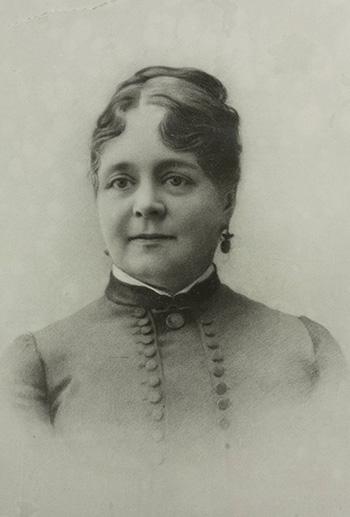When Mary Hitchcock Memorial Hospital in Hanover, New Hampshire, was demolished in 1995, three years after the new Dartmouth Hitchcock Medical Center (DHMC) opened in Lebanon, a century-old time capsule was discovered among the debris. Inside was a love letter to Mary Maynard Hitchcock, written by her husband Hiram Hitchcock, the wealthy hotelier who had built the hospital in 1893 as a memorial to his late wife. Hiram wrote of his childhood sweetheart, “It is a memorial of one of the noblest and best of God’s gifts to the human race. God grant that this hospital may be all, and more than all that she would have it to be. She was my life here. May God in His infinite mercy unite us again.”
Hiram’s grief was understandable. The couple had known each other since Mary was 8 and Hiram was 10, having both grown up in the small town of Drewsville, New Hampshire. Mary was born there in 1834 to Roxy Davis Maynard and John P. Maynard, and Hiram’s family moved from Claremont, New Hampshire, to Drewsville in 1842. After what was termed “a long courtship,” they were married in 1858, when Mary was 24. Hiram had already embarked on a successful career in the hotel business, having moved to New Orleans at age 20 to work at the renowned St. Charles Hotel and later at the Nahant House, a seaside resort hotel just outside of Boston.
After their wedding, Hiram and Mary moved to New York City, and a year later Hiram and two colleagues—Alfred B. Darling and Paran Stevens—built the Fifth Avenue Hotel, which was the largest and one of the most popular hotels in Manhattan. Mary became a prominent hostess, entertaining such luminaries as President Grover Cleveland and Theodore Roosevelt prior to his presidency. But, while their business and social lives were thriving, the couple’s personal life was consumed with loss. Their daughter Mary, born in 1863, lived only a month. A year later, when Mary was 31, their son Maynard was born, but he died just 14 months later.
Three years later, Hiram retired at the age of 34, reportedly due to ill health. During the years from 1866 through 1879, he and Mary traveled the world as Hiram pursued his interest in archaeology. While traveling in Europe, Hiram gave Mary a bracelet, earrings and a brooch that were copies of the crown jewels of Russia. During this time, they also bought a house in Hanover, New Hampshire, that had belonged to Dartmouth College Professor Henry Fairbanks. Dubbed “Hitchcock Mansion,” the large, French-style house stood where Russell Sage dormitory is now located, and their property stretched down to the Connecticut River.
The couple returned to New York City in 1879, as Hiram resumed his role of running the Fifth Avenue Hotel, and also helped found Madison Square Garden, serving as its president. They divided their time between Hanover and New York, but Mary died in New York of unknown causes in 1887 at the age of 53. Hiram initially commemorated her life by redecorating the Church of Christ at Dartmouth College in Hanover, which overlooked the northeast corner of the Dartmouth Green, and also buying the church a new organ. In 1889, he decided to further honor her memory by paying for the construction of a new hospital. Mary Hitchcock Memorial Hospital, which opened on May 3, 1893, would serve the Upper Valley’s residents, be a teaching hospital for Dartmouth (now Geisel) Medical School students and also train nurses. The Mary Hitchcock Memorial Hospital Training School for Nurses, which also opened in 1893, educated nurses for 87 years until its closing in 1980.
Built at an estimated cost of about $220,000, the state-of-the-art hospital was bright and airy and graced by impressive pillars, a fireplace carved from Siena marble and a beautiful mosaic tile floor. After Hiram officially donated the hospital to the corporation that would oversee it, he then addressed Dr. Carleton Frost, a close friend and dean of Dartmouth Medical School. He said, “This hospital is a lasting memorial of the great moral and sympathetic power of a noble Christian woman’s life in its devotion to the relief of human suffering and misery; and it is a precious privilege to have been permitted to establish a memorial that, under Providence, will realize the fond aspirations of that life.”
